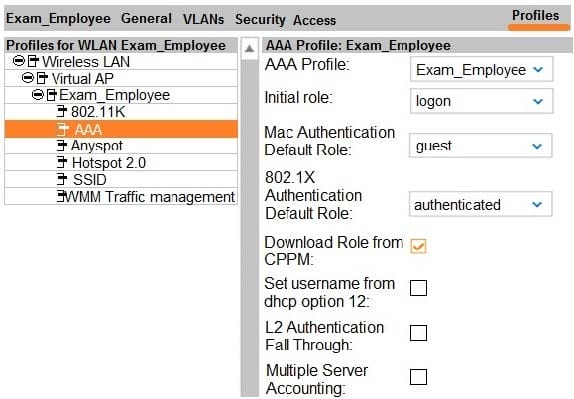HPE6-A42 Online Practice Questions and Answers
A WLAN in an Aruba Mobility Master (MM)-based solution enforces Enterprise-WPA2 security and uses the tunnel forwarding mode. The company has an external RADIUS server.
Which device exchanges RADIUS packets with the RADIUS server?
A. Mobility Controller (MC)
B. wireless client
C. access point (AP)
D. Mobility Master (MM)
A Mobility Controller (MC) runs ArubaOS 8. What is a valid reason for an administrator to set the MC to master-local mode?
A. The company already has a partially hierarchical deployment based on the 6.x code and wants to keep the current architecture.
B. The company needs to manage third-party network infrastructure devices with the use of the master controller interface.
C. The company wants a deployment architecture that allows administrators to configure all MC settings from a single location.
D. The company requires a centralized licensing architecture that provides global license pools.
A company has an Aruba solution and wants to provide guests with wireless access. The company wants to assign guests IP addresses in subnets that exist only within the Aruba solution.
Which feature should network administrators set up so guests can send traffic on the Internet without changes to the company routing solution?
A. Enable NAT on the VLAN assigned to the guest WLAN.
B. Set up a dynamic default gateway on the Mobility Controllers (MCs).
C. Create destination NAT rules for the guest role.
D. Enable policy-based routing for the guest traffic.
Network administrators use the wizard to create a WLAN that uses WPA2-Enterprise security to a RADIUS server at 10.21.98.55. They do not manually change any settings.
Which device determines the EAP type that the wireless clients must support?
A. Mobility Master (MM)
B. Mobility Controller (MC)
C. RADIUS server
D. AP
A network administrator has installed PEF licenses in the global pool of a Mobility Master (MM) solution. When the administrator tries to configure roles and policies, an error indicates that the PEF licenses must be installed.
What should the administrator do to correct this issue?
A. Ensure the PEF licenses were installed at the Managed Network and not at the MM level.
B. Enable Building 1 as a local license pool.
C. Enable the PEF feature in the Global Usage window.
D. Activate the PEF licenses through an Aruba Activate account.
Which authentication server option would the network administrator choose to authenticate a wireless user directly against an Active Directory (AD) domain controller without NPS or IAS?
A. LDAP server
B. RFC 3576 server
C. TACACS server
D. RADIUS server
What are two criteria that distinguish different Aruba Mobility Controller (MC) models from each other?
A. firewall speed and ability to act as a standalone controller or not
B. number of supported users and firewall throughput
C. number of supported APs and ability to support 802.11ac APs or not
D. number of supported users and ability to support 802.11ac APs or not
What is one reason for a network administrator to visit the Dashboard > Usage window on an Aruba Mobility Master (MM)?
A. to check license usage and determine the need for additional licenses
B. to analyze short terms trends in network usage by client, AP, and application
C. to view system usage statistics for the MM and troubleshoot potential issues
D. to generate reports about traffic patterns and network usage over the past several months
What is one networking setting that a network administrator can configure for roles in an Aruba solution?
A. DHCP pool
B. ClientMatch rules
C. source NAT
D. bandwidth limit
A company has an Aruba Mobility Master (MM)-based solution. Where can a network administrator look to find a list of alerts about a variety of issues on the MM or managed devices?
A. the Potential Issues dashboard
B. the top banner
C. the MM Maintenance pages
D. the Performance dashboard
Refer to the exhibit.

A network administrator adds a global rule in the area shown in the exhibit. Where does the global rule take effect?
A. It immediately applies only to the guest role, as part of the final policy applied to the role. Administrators cannot apply the rule to other roles.
B. It immediately applies to the guest role and other roles, as part of the first policy applied to the role.
C. It immediately applies to the guest role and other roles, as part of the final policy applied to the role.
D. It immediately applies only to the guest role and other roles, as part of the first policy applied to the role. Administrators can choose to apply the rule to other roles.
An Aruba Mobility Master (MM)-based solution has two Virtual MM nodes, a primary and a backup node. The solution must support 30 Virtual Mobility Controllers (VMCs) that will support a total of 960 APs.
Which VMC licenses meet the needs and DO NOT unnecessarily exceed them?
A. two 1000 VMC licenses (MC-VA-1000)
B. one 1000 VMC license (MC-VA-1000)
C. two 50 VMC licenses (MC-VA-50)
D. one 50 VMC license (MC-VA-50)
What is one difference between an Aruba firewall access controle rule and an application rule?
A. An application rule cannot use the packet source and destination IP addresses as part of its match criteria.
B. An access rule can filter non-IP traffic, as well as IPv4 and IPv6 traffic.
C. An access rule cannot apply different actions to different types of traffic sent to the same destination.
D. An application rule can filter traffic at a higher layer beyond the TCP or UDP port.
Refer to the exhibit.

The exhibit shows the AAA profile for a WLAN on an Aruba solution. This WLAN uses 802.1X to
authenticate users to a RADIUS server. A user successfully authenticates with 802.1X, but the RADIUS
server does not send a role assignment.
How does the Aruba firewall handle the role assignment for this user?
A. It does not assign a role.
B. It applies the Aruba VSA role employee.
C. It assigns the logon role.
D. It assigns the authenticated role.
An Aruba solution has a WLAN that uses WPA2-Personal security. How are encryption keys dynamically managed for the wireless users?
A. The MM generates and distributes keys to clients and access points (APs).
B. Administrators configure identical key strings on the Mobility Controllers (MCs) and wireless client 802.1X settings.
C. Keys are generated and distributed securely during each wireless user authentication process.
D. Keys are derived from the preshared key configured on the WLAN and on each wireless client.
